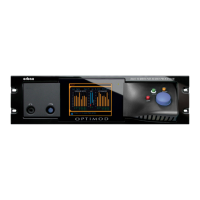OPTIMOD SURROUND PROCESSOR INSTALLATION
2-25
When the SDI VIDEO DELAY control (INPUT/OUTPUT 4 screen) is set to AUTO, the
8685 can calculate the amount of video delay automatically. To do this with Pen-
teo, the 8685 must have an Ethernet connection to the Penteo unit so that the
8685 can detect that the Penteo unit is connected.
If the 8685 does not recognize the Penteo, you must set the video delay manu-
ally. Set the video delay to one frame (for the 8685’s audio processing) plus seven
frames for Penteo. If the optional Dolby-E decoder module is installed and pass-
ing audio, add one frame of video delay. If the optional Dolby-E encoder module
is installed and passing audio, add an additional one frame of video delay. With
all options installed (Penteo, Dolby-E decode, and Dolby-E encode), the required
video delay is 10 frames (1+7+1+1).
6. Set the 2.0 input deemphasis.
[Flat, J.17]
You can configure the 8685 to apply J.17 deemphasis to input signals assigned to
the 2.0 processing. J.17 is first-order shelving preemphasis/deemphasis with
breakpoints at 400 Hz and 4 kHz. It is rarely used now; in broadcasting, it was
mostly used in NICAM links.
A) L
OCATE to INPUT/OUTPUT > INPUT.
B) Set the 2.0
INPUT PREEMPHASIS control to FLAT or J.17. If in doubt, choose FLAT,
which is correct for almost all installations.
C) Set the 2.0
INPUT PREEMPHASIS control to FLAT or J.17
7. Adjust the surround input reference Level.
[
−
40 dBfs to –10 dBfs (VU), or [
−
33 dBfs to –3 dBfs (PPM)] in 0.5 dB steps
This step matches the 8685’s average AGC gain reduction to the level to which
program material is normally peaked on the studio meters. It makes the 8685’s
processing presets operate in their preferred range. Correctly setting the input
reference level ensures that processing presets will produce their intended
sound, controlling loudness effectively and subtly.
• If your organization uses a standardized line-up level, you can simply set the
8685’s S
URROUND INPUT REFERENCE VU control to this level and skip to step (H).
However, we strongly suggest checking the result of your setting
by using the
procedure starting with step (A) and choosing to calibrate using program
(step (G)).
There are two commonly used line-up levels: SMPTE (–20 dBfs) and EBU
(–18 dBfs).
• Note that you are calibrating to the average indication of the studio meters;
this is quite different from the actual peak level.
• The reference level VU (average) and PPM (quasi-peak) settings are not inde-
pendent—they track each other with an offset of 7 dB. This compensates for

